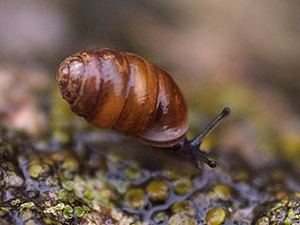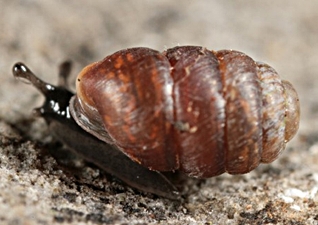Class:
Gastropoda
![]() Subclass:
Pulmonata
Subclass:
Pulmonata
![]() Superorder:
Eupulmonata
Superorder:
Eupulmonata
![]() Order:
Stylommatophora
Order:
Stylommatophora
![]() Suborder:
Orthurethra
Suborder:
Orthurethra
![]() Superfamily:
Pupilloidea
Superfamily:
Pupilloidea
![]() Family:
Pupillidae Turton 1831
Family:
Pupillidae Turton 1831
![]() Source: Mollbase on
http://www.mollbase.de/list/.
Source: Mollbase on
http://www.mollbase.de/list/.
Chrysalis snails have their name from their outward resemblance with a holometabole insect's chrysalis. They are usually larger than whorl snails (Vertiginidae) and have distinct, if short, lower tentacles. Chrysalis snails are very widely distributed, they can be found on all continents, except Antarctica; in Europe their distribution in the north stretches beyond the Arctic circle, in the Alps beyond 2000 m MSL.
The common name chrysalis snails is used for whorl snails (Vertiginidae), as well as Lauriidae and Pupillidae, all of which share the same superfamily, Pupilloidea.
Moss Snail - Pupilla muscorum (Linnaeus 1758)
 Moss snail (Pupilla muscorum). Picture: © Stefan Haller (schneckenfoto.ch). |
Description: The moss snail usually has a light brown shell, whose colour may vary between reddish brown and yellowish horn colour. The shell is slightly striated, but may also almost have a smooth surface. The whorls are slightly rounded at the outside, the suture separating them is not very deep. The aperture lip usually is well developed, and on the back of the apertural whorl the snail has a prominent callus well visible because of its whitish colour. In the shell mouth there usually is a parietal (upper) tooth; there may also be a palatal (lower) tooth or lamella, which often melts with the shell wall.
The snail's body is small with an elliptic foot, which is dark coloured, becoming lighter coloured at the flanks and the sole. The upper tentacles are not very long, the lower ones are very short.
Dimensions: H: 3 - 4 mm; W: 1.65 - 1.75 mm; U: 5 - 6½. (Abbreviations).
 Moss snail (Pupilla muscorum). Picture: © Malcolm Storey (Bioimages.org.uk). |
Habitat and Distribution: Moss snails live on dry meadows, even on sand hills and in more or less open and sunny places. The snail usually prefers calciferous ground, but is also described as indifferent to the ground limestone content (Ehrmann, P. (1956), p. 46). In Portugal it can also be found under stones, in the leaf litter and in mosses. In Great Britain it is also often found on calciferous sheep pastures.
Moss snails are ovoviviparous snails - their eggs can hibernate inside the mother's body and be laid in spring, when favourable conditions prevail. While the juveniles of Pupilla muscorum usually hatch during oviposition (and then crawl around with the amnion over their shells), the embryos of the Alpine chrysalis snail (Pupilla alpicola) need some additional days to develop before hatching.
The species' distribution area stretches over the northern Hemisphere (the Holarctic, see also Faunal provinces of the Earth) - moss snails practically are found everywhere in Europe. In the Alps the altitude limit for Pupilla muscorum is 1500 m MSL (Ehrmann (1956), see above), whereas the Alpine chrysalis snail, for example, can be found as high as 2400 m MSL.
![]() Anderson, R. (2008): "An annotated list of the non-marine Mollusca of Britain and
Ireland" (PDF).
Anderson, R. (2008): "An annotated list of the non-marine Mollusca of Britain and
Ireland" (PDF).
![]() Francisco
Welter-Schultes:
Pupilla muscorum species homepage.
Francisco
Welter-Schultes:
Pupilla muscorum species homepage.
 With pictures by Stefan Haller: http://www.schneckenfoto.ch. |